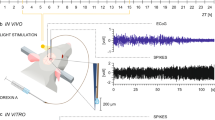Abstract
Recent immunohistochemical evidence from the rat, indicating that γ-aminobutyric acid (GABA)-containing fibres of central nervous origin project to the pars intermedia of the pituitary1,2, prompts inquiry into the function of this innervation. There is electrophysiological evidence that GABA acts directly on melanotrophs isolated from rat, through bicuculline-blockable receptors, to increase Cl− conductance and thereby drive the membrane potential towards the Cl− equilibrium potential in these cells, resulting in depolarization at rest or reduction of the depolarization caused by excess K+ (ref. 3). As voltage-dependent Ca channels can participate in the regulation of secretion in these cells4, we have now examined the effect of GABA on hormone output and find that it first stimulates and then inhibits spontaneous secretion of melanocyte-stimulating hormone (MSH) and inhibits K+-evoked secretion. Moreover, our pharmacological evidence suggests that similar receptors are involved in the secretory and the electrophysiological responses. A function of the GABAergic innervation may therefore be to regulate hormone output by acting directly on the melanotrophs, and this regulation may be affected by the changes in electrical properties induced by GABA.
This is a preview of subscription content, access via your institution
Access options
Subscribe to this journal
Receive 51 print issues and online access
$199.00 per year
only $3.90 per issue
Buy this article
- Purchase on Springer Link
- Instant access to full article PDF
Prices may be subject to local taxes which are calculated during checkout
Similar content being viewed by others
References
Oertel, W. H. et al. Proc. natn. Acad. Sci. U.S.A. 79, 675–679 (1982).
Vincent, S. R., Hökfelt, T. & Wu, J.-Y. Neuroendocrinology 34, 117–125 (1982).
Taraskevich, P. S. & Douglas, W. W. Nature 299, 733–734 (1982).
Tomiko, S. A., Taraskevich, P. S. & Douglas, W. W. Neuroscience 6, 2259–2267 (1981).
Jackson, S., Hope, J., Estivariz, F. & Lowry, P. J. Ciba Fdn Symp. 81, 141–153 (1981).
Douglas, W. W. & Taraskevich, P. S. J. Physiol., Lond. 285, 171–184 (1978).
Douglas, W. W. & Taraskevich, P. S. J. Physiol., Lond. 309, 623–630 (1980).
Tsuruta, K., Grewe, C. W., Cote, T. E., Eskay, R. L. & Kebabian, J. W. Endocrinology 110, 1133–1140 (1982).
Douglas, W. W. Ciba Fdn Symp. 54, 61–90 (1978).
Nistri, A. & Constanti, A. Prog. Neurobiol. 13, 117–235 (1979).
Hadley, M. E. & Bagnara, J. T. Am. Zool. 15, Suppl. 1, 81–104 (1975).
Hadley, M. E., Davis, M. D. & Morgan, C. M. in Frontiers of Hormone research Vol. 4, 94–104 (Karger, Basel, 1977).
Howe, A. J. Endocr. 59, 385–409 (1973).
Tilders, F. J. H., Van der Woude, H. A., Swaab, D. F. & Mulder, A. H. Brain Res. 171, 425–435 (1979).
Munemura, M., Eskay, R. L. & Kebabian, J. W. Endocrinology 106, 1795–1803 (1980).
Hopkins, C. R. & Farquhar, M. G. J. Cell Biol. 59, 276–303 (1973).
Author information
Authors and Affiliations
Rights and permissions
About this article
Cite this article
Tomiko, S., Taraskevich, P. & Douglas, W. GABA acts directly on cells of pituitary pars intermedia to alter hormone output. Nature 301, 706–707 (1983). https://doi.org/10.1038/301706a0
Received:
Accepted:
Issue Date:
DOI: https://doi.org/10.1038/301706a0
This article is cited by
-
GABA-mediated synaptic transmission in neuroendocrine cells: a patch-clamp study in a pituitary slice preparation
Pfl�gers Archiv European Journal of Physiology (1992)
-
Patch-clamp analysis of voltage-gated currents in intermediate lobe cells from rat pituitary thin slices
Pfl�gers Archiv European Journal of Physiology (1992)
-
Secretory morphology of the intermediate lobe of the rat pituitary incubated in vitro
Cell and Tissue Research (1988)
-
Immunocytochemical study of the GABAergic innervation of the mouse pituitary by use of antibodies against gamma-aminobutyric acid (GABA)
Cell and Tissue Research (1987)
-
Spontaneous and GABA-evoked chloride channels on pituitary intermediate lobe cells and their internal Ca requirements
Pflügers Archiv - European Journal of Physiology (1987)
Comments
By submitting a comment you agree to abide by our Terms and Community Guidelines. If you find something abusive or that does not comply with our terms or guidelines please flag it as inappropriate.



